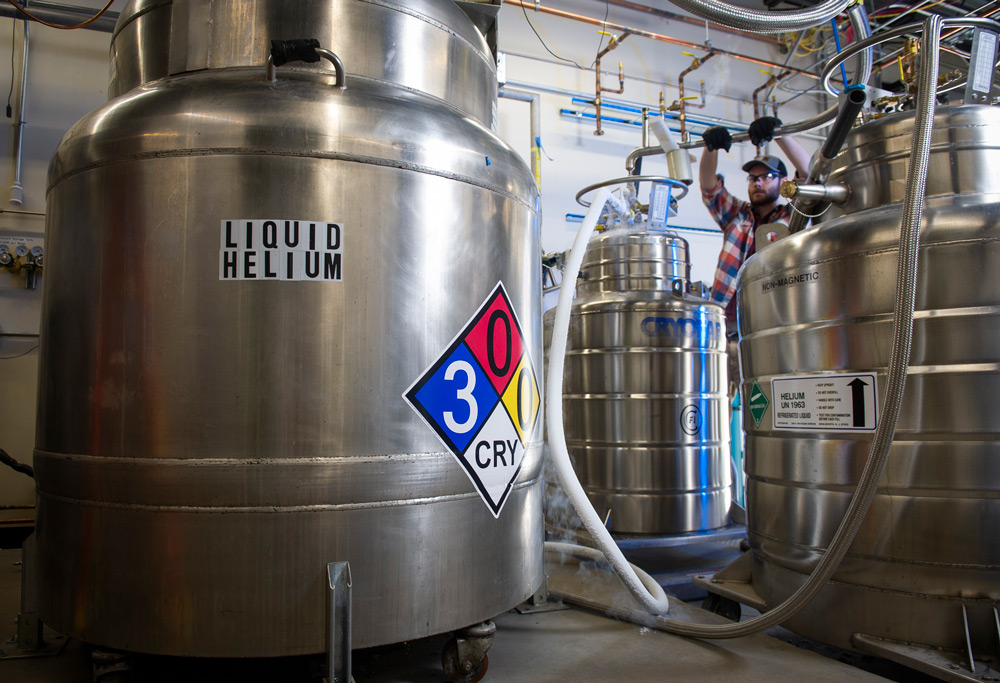Reduce, Reuse, Recycle, for Helium’s Sake

When was the last time you knowingly encountered helium, the gas that makes balloons float and children—OK, adults too—giggle and talk in high, squeaky voices after inhaling it? Likely at a birthday party, wedding, or another celebration, right?
Helium, however, has many applications beyond party balloons. Pure, high-quality helium is critical to several industries and technologies, including quantum computing.
“Many quantum computing technologies use helium,” said Steve Sanders, director of engineering at Quantinuum, which develops trapped-ion quantum computing technologies. “We use it to keep our ion traps very cold because they operate better below 50 degrees Kelvin. The helium also has the effect of lowering the gas pressure inside our physics packages and keeping the few remaining gas atoms cold. Fewer gas atoms mean fewer collisions with our ions. And cold gas atoms have far less energy, so even if they collide with our ions, they don’t disturb them.”
Found among the stars, helium is one of the most abundant elements in the universe, second only to hydrogen. On earth, where it’s formed from alpha-particles of radioactive elements decaying beneath the surface, helium is a finite resource. And that’s why Quantinuum has significantly invested in staff and infrastructure to reuse as much helium as possible.

“We recognize the physical and socioeconomic impacts of both limited natural resources and climate change, so it’s crucial for us to operate as sustainably as possible,” said Tony Uttley, president and chief operating officer at Quantinuum.
Andy Miller, an engineer at Quantinuum, spends his days managing and maintaining the extensive helium recovery system at the company’s Colorado campus. (Quantinuum has a smaller system at its laboratory space in Minnesota.)

“Our helium liquefaction system is a process plant that converts helium from a gas into a liquid. That liquid is then moved into the labs where it provides cooling to the quantum computing application. As it provides cooling, it becomes a gas again and then is transported into our recovery pipeline, which is installed throughout the facility, and the recovery piping leads to a big gasbag,” Miller explains.

“This gasbag is a giant balloon that fills up with gaseous helium. And as that balloon fills up with helium, it is monitored by a level sensor that measures the size of the gas bag. Once the bag inflates to a certain volume, it turns on a high-pressure compressor. The high-pressure compressor then pulls helium from the gas bag and sends the helium over to high-pressure storage. The helium is stored in high-pressure cylinders which are 20 feet in length and two feet in diameter. It's stored as a high-pressure gas until it's ready to be liquefied again and sent back to the labs to continue the cooling and recycle process.”
This process enables the team to recover and reuse large amounts of helium.
“Helium is an absolutely 100% nonrenewable resource,” Miller emphasizes. “Once we pull helium out of the ground, it is so light that it will float up out of the atmosphere. It’s important we recover and reuse as much of it as possible.”
Kaniah is Chief Legal Counsel and SVP of Government Relations for Quantinuum. In her previous role, she served as General Counsel, Honeywell Quantum Solutions. Prior to Honeywell, she was General Counsel, Honeywell Federal Manufacturing and Technologies, LLC, and Senior Attorney, U.S. Department of Energy. She was Lead Counsel before the Civilian Board of Contract Appeals, the Merit Systems Protection Board, and the Equal Employment Opportunity Commission. Kaniah holds a J.D. from American University, Washington College of Law and B.A., International Relations and Spanish from the College of William and Mary.

Jeff Miller is Chief Information Officer for Quantinuum. In his previous role, he served as CIO for Honeywell Quantum Solutions and led a cross-functional team responsible for Information Technology, Cybersecurity, and Physical Security. For Honeywell, Jeff has held numerous management and executive roles in Information Technology, Security, Integrated Supply Chain and Program Management. Jeff holds a B.S., Computer Science, University of Arizona. He is a veteran of the U.S. Navy, attaining the rank of Commander.

Matthew Bohne is the Vice President & Chief Product Security Officer for Honeywell Corporation. He is a passionate cybersecurity leader and executive with a proven track record of building and leading cybersecurity organizations securing energy, industrial, buildings, nuclear, pharmaceutical, and consumer sectors. He is a sought-after expert with deep experience in DevSecOps, critical infrastructure, software engineering, secure SDLC, supply chain security, privacy, and risk management.

Todd Moore is the Global Vice President of Data Encryption Products at Thales. He is responsible for setting the business line and go to market strategies for an industry leading cybersecurity business. He routinely helps enterprises build solutions for a wide range of complex data security problems and use cases. Todd holds several management and technical degrees from the University of Virginia, Rochester Institute of Technology, Cornell University and Ithaca College. He is active in his community, loves to travel and spends much of his free time supporting his family in pursuing their various passions.

Retired U.S. Army Major General John Davis is the Vice President, Public Sector for Palo Alto Networks, where he is responsible for expanding cybersecurity initiatives and global policy for the international public sector and assisting governments around the world to prevent successful cyber breaches. Prior to joining Palo Alto Networks, John served as the Senior Military Advisor for Cyber to the Under Secretary of Defense for Policy and served as the Acting Deputy Assistant Secretary of Defense for Cyber Policy. Prior to this assignment, he served in multiple leadership positions in special operations, cyber, and information operations.




